Modelling the Skew Quadrupole Component
-- Effects of Coil Offsets and Widening --
Special Meeting on Production of 8-Pole Wigglers
17 November 2003
This talk briefly reviews the prior studies of coil offsets, which were
primarily for the 7-pole design, then presents modelling results for
an 8-pole wiggler where alternate upper 20-cm coils are offset
in a zig-zag pattern, showing that this effect results in a large
first integral which is not observed in the measurements. Then a model
where the two same-polarity upper 20-cm poles are widened maintaining
left/right symmetry, as suggested by Eric Smith (see meeting of 10 Nov 03),
is presented. This model appears promising as an explanation of the
measured skew quad component in the present wiggler construction.
Finally, a model of the warm test set-up now in use for coil production
provides information on the acceptance criteria presently applied
to coil production relative to the magnitude of the observed skew
quad components in the measured field integrals.
Postscript files are also available via the links below.
- The effect of coil offsets has been studied in the past
(
25Oct02,
1Nov02,
22Nov02,
6Dec02,
10Jan03,
31Jan03,
7Feb03
), but primarily
for the 7-pole design, since the 8-pole designs did not show big skew quad components until recently. At that time, coils were always offset horizontally, breaking the left/right symmetry in a way thought to be necessary to generate the skew quad component. They were simultaneously widened by the amount needed
to avoid overlapping the coil with the pole steel. Modelling a single pole offset by 50 mils in wiggler Nr 2 shows that
the first integral of the horizontal field component Bx does depend on X,
but not as linearly as the measurements show, and that 50 mils is not sufficient to generate the observed slope. A model which used this method to incorporate
the coil offsets measured during construction of Wiggler Nr 2 proved that this approach could not account for the large
skew quad component measured at the time. Note also that the combined
effect of all the offsets exhibits the same curvature in the dependence
of the integral on X as shown by the single-coil offset, a characteristic
which is not observed in the measurements of the field integrals.
For this reason, this line of
investigation was abandoned.
However, this is only one way
of accounting for the measured coil positions. Since the coil position
measurement is simply the distance between the outer end of the coil
relative to the steel on both sides, it does not specify if these deformations
are due to an offset or a widening. The modelling of the 7-pole wiggler
chose to subtract the left and right measured coil positions and widen AND shift the coil accordingly. Eric Smith has recently suggested that a symmetric
widening of the coils will yield a skew quad effect, and this is verified
in the full 8-pole wiggler model below. The above modelling assumption for
the 7-pole models would have resulted in no modification of the wiggler field
for such coil positioning, since it is sensitive only to left/right asymmetries.
-
The next four slides show the results of a model in which the four upper
20-cm coils of the 8-pole wiggler are offset and widened by 1.5 mm in
a zig-zag pattern
in the manner used to model the 7-pole coil offsets. (In this picture,
the pattern is seen as almost imperceptible gaps between the coils
and the steel on alternating sides of the poles.)
The integral of Bx shows that this magnitude of
offset generates a large integral at X=0, as well as a quadratic
symmetric dependence on X rather than linear, both in contradiction with
measurement. Also shown are the integrals and
horizontal uniformity of the vertical component
of the field.
- The model in which two alternate upper 20-cm coils are simply widened
by 1.5 mm in the horizontal direction with no offset shows an
integral of the horizontal field component which
is remarkably similar to the measured integral. It rises roughly linearly
with X, and is antisymmetric around X=0. The magnitude of the slope
for the 1.5 mm widening of these two poles is about 3/4 of the slope
observed for Wiggler Nr 2. Also similar to measurement is the
integral of the vertical component, which
is about 8 gauss-meters nearly independent of X. The
horizontal uniformity of the vertical component
remains within specification (3 per mil) and exhibits the left/right
symmetry of the model, incontrast to the antisymmetry resulting from
coil offsets.
-
Coil deformations of this type should be detected in the warm single-pole
test, which has also been modelled. Measurements are available for
the Z-dependence of the integral of the vertical component over X. Comparison of the undeformed coil with the coil widened by
1.5 mm shows that a change in the integral of about 10 gauss-meters
can be expected. Sasha reported in this meeting that this corresponds
to an acceptance criterion (dN = 1 unit) in his measurement apparatus of about 0.25 mm in the width of the coil. The skew quad component measured for
Wiggler Nr 9 is 1.2 gauss-m/cm. The model with the two coils widened
by 1.5 mm gives a slope of 1.4 gauss-m/cm (see above).
So an unfortunate coincidence
of (1.5/0.25) * 1.2 / (1.4/2) = 10 poles, each providing 0.25-mm worth of
widening
could produce the observed skew quad component in Wiggler Nr 9.
From this point of view, the acceptance criterion dN=1 appears marginal.
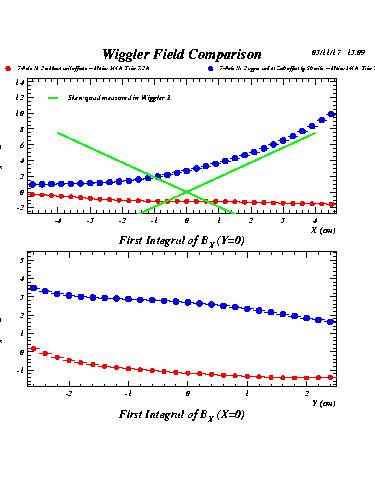
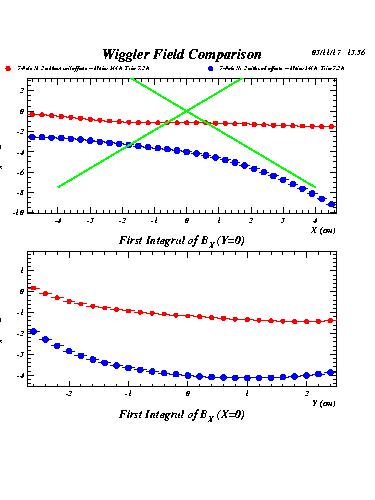
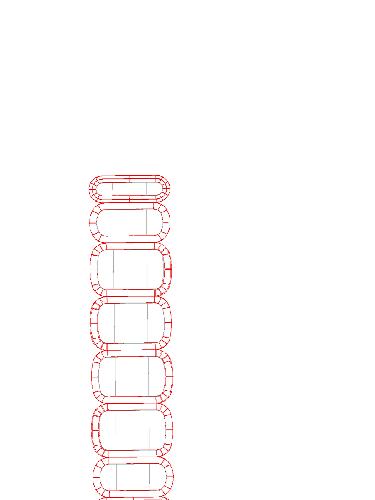
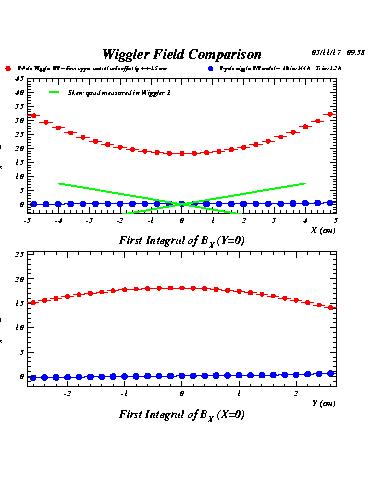
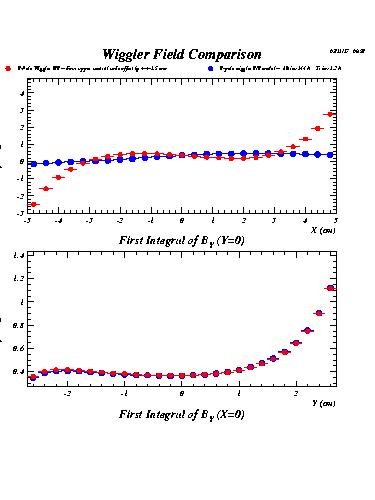
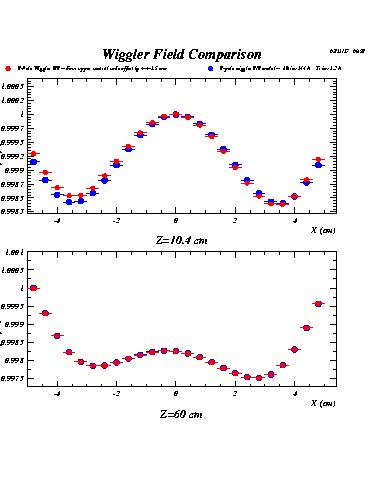
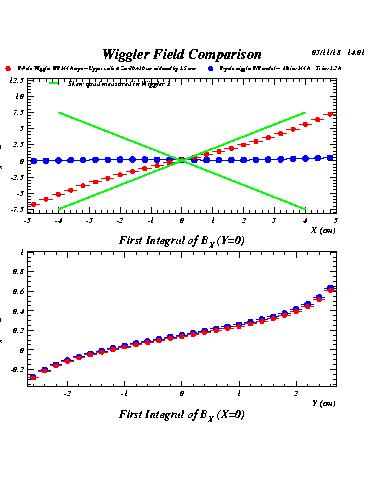
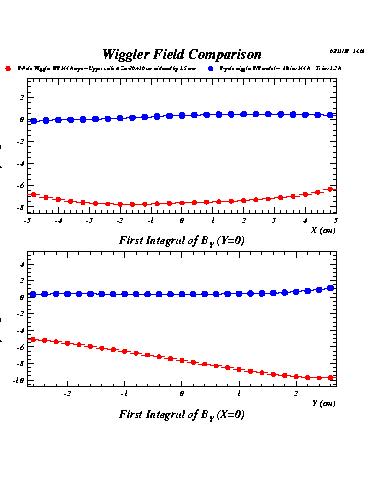
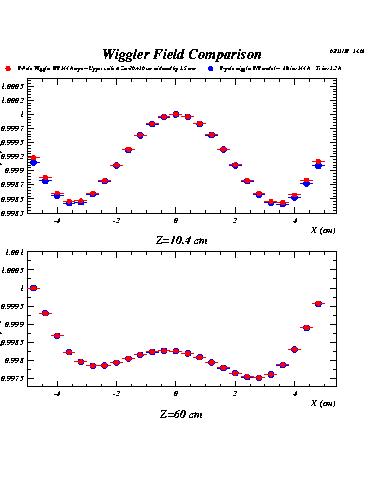
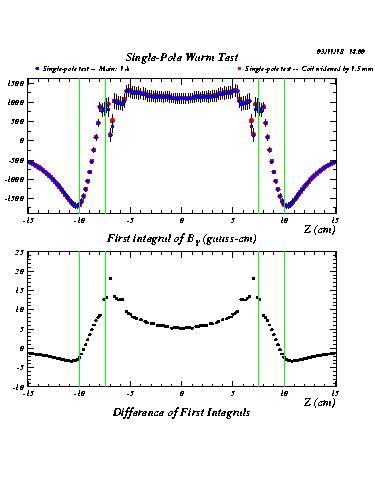
Creation date: 11/18/03.









